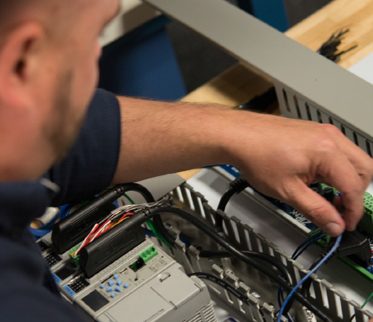Electrical control systems are used on everything from simple pump controls to car washes, to complex chemical processing plants. Automation of industrial machinery, tools and more has increased productivity and reliability in all areas of manufacturing, utilities and material processing. When an operation or process used to produce an end product is very laborious, time consuming, and produces inconsistent results, automating the process reduces manual labor, improves throughput and produces consistent results.
Whether you have the skills to develop the system or use a qualified System Integrator, it is always beneficial to understand automation control system devices and their terminology to ensure development of a system that will run efficiently and prevents any injury or damage to equipment.
The most important topics to understand include:
- Safety
- Identifying an operation or process that could benefit from automation
- Control device specification
- Control system design and construction
- Control system installation
- Control system maintenance
The most important item to consider before attempting an automated control system, or even a simple on/off control for a pump, is safety, both for personnel who may be working with or near the automated equipment, as well as to prevent damage to the equipment. To minimize the risk of potential safety problems, you should follow all applicable local, state and national codes that regulate the installation and operation of your control system, along with the equipment or process it is designed to control. You should also consider lockout/tagout procedures as specified by Occupational Safety and Health Administration (OSHA). Safety should always be the most important consideration with every step of the automation control system design.
 The first step to configure an automated control system is to identify what machines, procedures and processes can be automated. A good understanding of basic electricity, safety, hydraulics, pneumatics, mechanical operating mechanisms, electronics, control sequences, etc. is extremely important. It is also important to have a solid knowledge of the operation or process that you are going to automate.
The first step to configure an automated control system is to identify what machines, procedures and processes can be automated. A good understanding of basic electricity, safety, hydraulics, pneumatics, mechanical operating mechanisms, electronics, control sequences, etc. is extremely important. It is also important to have a solid knowledge of the operation or process that you are going to automate.
The next step is to specify the various devices required for controlling the equipment in an automated system. Your specifications need to include not only the “controlling” devices for your application, but also items such as the housing or enclosure for the devices, the type of wire required to meet the various codes, agency approvals required for safety and insurance purposes, environmental conditions, etc. The first skill we need to develop in this effort will be the gathering of all the equipment parameters and specifications needed to specify the devices required to control the equipment.
Then you may proceed to the design of the automated control system, which includes planning by defining our sequence of operation, creating a schematic with the devices shown in a high-voltage to low-voltage order, input to output design layout, panel layout, wiring diagrams, bill of materials, software tools to document our design, choices between using hard-wired relays versus a PLC with programming, etc.
With the design portion ready, we can jump to the steps needed to build, start up, and maintain the automated control system. To build the system you will need tips on the use of a subpanel, terminal blocks, grounding, shielded cable, etc. You will also need to know steps to start up the system so that it is brought online in a safe and logical manner, and you will also need some suggestions for developing a plan to maintain the control system.
To properly design an automation control system, it is important to be familiar with all the items mentioned above. Be sure to have the knowledge of every facet of an automation system or to hire a System Integrator that will help you design a safe and efficient system. For more information on how to specify, design, install and maintain an automation control system, check out our Condensed Guide to Automation Control System Specification, Design and Installation whitepaper here.
*Originally published: Nov 7, 2018

